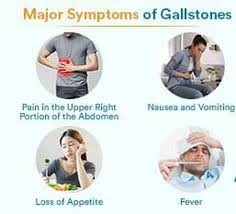Which assessment findings will the nurse anticipate in the client with cholelithiasis?
Coffee ground emesis, nausea/vomiting
Right lower quadrant abdominal pain, constipation.
Absent bowel sounds, abdominal pain
Right upper quadrant abdominal pain, nausea/vomiting
The Correct Answer is D
Cholelithiasis refers to the presence of gallstones in the gallbladder or bile ducts. The most common symptom is right upper quadrant abdominal pain, which may be colicky or steady. Nausea and vomiting are also commonly associated with cholelithiasis.
Coffee ground emesis and constipation are not typical findings associated with cholelithiasis. Absent bowel sounds may be a sign of bowel obstruction but are not specific to cholelithiasis.

Nursing Test Bank
Naxlex Comprehensive Predictor Exams
Related Questions
Correct Answer is A
Explanation
After spinal fusion surgery, it is important to limit the patient's activity and movement to allow for proper healing and to prevent complications. The order to have the patient out of bed three times daily and ad lib (as desired) is not appropriate immediately after surgery.
The other orders listed are appropriate for the postoperative care of a patient who has undergone spinal fusion surgery:
- Assess neurological status every 4 hours: This is important to monitor for any changes in neurological function, which could indicate complications such as nerve damage or spinal cord compression.
- Logroll only to change position: Logrolling is a technique used to move patients with spinal fusion surgery while keeping their spine aligned and minimizing stress on the surgical site. This order is appropriate to ensure proper positioning and prevent injury to the surgical area.
- Monitor vital signs every 4 hours: Monitoring vital signs helps to assess the patient's overall condition and detect any signs of complications such as bleeding or infection.
Correct Answer is A
Explanation
A 3% saline solution is a hypertonic solution used to increase serum sodium levels in cases of severe hyponatremia. However, it can lead to fluid overload and pulmonary edema. The presence of crackles throughout both lung fields indicates the accumulation of fluid in the lungs, which is a serious adverse outcome.
The patient's radial pulse rate of 105 beats/min is within a normal range and does not directly indicate an adverse effect of the saline infusion.
The presence of sediment and blood in the patient's urine may be unrelated to the 3% saline infusion and could indicate other issues such as urinary tract infection or kidney injury.
An increase in blood pressure from 66/50 to 122/74 mmHg is an expected effect of a hypertonic solution like 3% saline, as it can cause an increase in intravascular volume. While the increase in blood pressure is significant, it does not represent an adverse outcome specific to the infusion itself.
Whether you are a student looking to ace your exams or a practicing nurse seeking to enhance your expertise , our nursing education contents will empower you with the confidence and competence to make a difference in the lives of patients and become a respected leader in the healthcare field.
Visit Naxlex, invest in your future and unlock endless possibilities with our unparalleled nursing education contents today
Report Wrong Answer on the Current Question
Do you disagree with the answer? If yes, what is your expected answer? Explain.
Kindly be descriptive with the issue you are facing.
